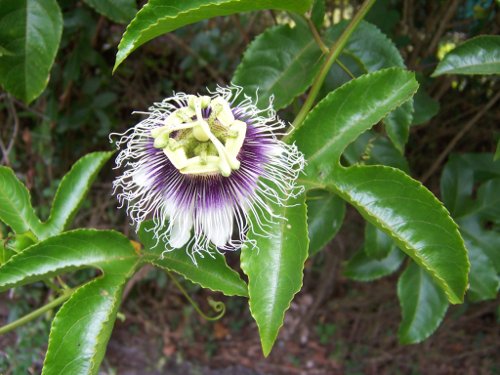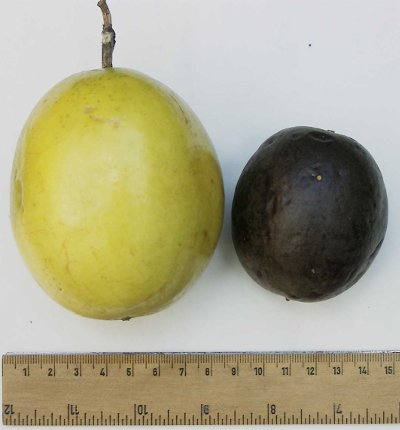Passionfruit

Scientific name: Passiflora edulis
Climate: Temperate
Plant description: It is a climbing plant that can reach 9 meters in height, but only when the growing conditions are right. Its life cycle does not exceed a decade. It has a stiff and woody stem. It has alternating dark green leaves of large size, perennial and smooth.
The flower is single, showy and very fragrant, it can reach five centimeters in diameter in wild varieties, it is normally white, with pinkish or reddish tints in P. edulis; There are other species in the family that have colors that range from deep red to pale blue.
The fruit is an ovoid berry that can have 180 to 200 seeds inside, there are yellow, purple and orange. The roots, as usual in climbing plants, are superficial.
It is native to the Amazon of Brazil, Paraguay and Peru.
Cultivation: It adapts to different soils, from sandy to clayey and can be established both in flat and sloping areas, although you prefer deep soils (greater than 60 cm), loose, well drained and without salinity problems.
The best soils for passion fruit are those with a slight slope (10%), a sandy loam texture with good moisture retention capacity and medium to high fertility.
Prefers cool temperatures. The root system is superficial and branched, of very rapid development. It is grown in a wide range of altitude (0-1300 meters above sea level).
Seeds can be extracted from fresh fruit, rubbed until the juice sacs are broken, washed with water and allowed to dry for 3-4 days before being washed again and dried in the shade.
They are sown in a soil mixture made with equal parts compost, topsoil and coarse sand, they should germinate after 10 to 20 days. When the seedlings grow to a height of 20 to 25 cm they are ready to be transplanted.
It is a tropical plant that requires constant and abundant watering. It needs a tutored system that can be trellised or trellised, it should be planted in rows from east to west to maximize its exposure to the sun.
 Uses: Passion fruit is credited with many healing properties. It prevents infections and helps the function of the immune system thanks to its vitamin A content, takes care of vision, protects the skin, nails and hair. Fight constipation, as it contains a lot of fiber.
Uses: Passion fruit is credited with many healing properties. It prevents infections and helps the function of the immune system thanks to its vitamin A content, takes care of vision, protects the skin, nails and hair. Fight constipation, as it contains a lot of fiber.
Due to its magnesium content, this fruit is a great ally for the proper functioning of the nervous system. It acts against premature aging due to its polyphenol content. Improves memory thanks to phosphorus. It also has antioxidant, vasodilator, anti-inflammatory, analgesic and sedative action.
The leaves of the passion fruit plant can be taken as an infusion to relieve cough, menstrual pain, muscle pain, intestinal problems or to combat insomnia.
The passion fruit oil base is used as a cosmetic product in creams, shampoos, lotions, oils, soaps, etc. It can also be used both in food and feed.
References:
colaboradores de Wikipedia. (2020, August 2). Passiflora edulis. Wikipedia, La Enciclopedia Libre. https://es.wikipedia.org/wiki/Passiflora_edulis
Gob Antioquia. (2014, June 4). Producción de Maracuyá en Escuela de Campo. YouTube. https://www.youtube.com/watch?v=l2BMS8VlxNo
Rodriguez, I. (2020, May 6). Cultivo de Maracuyá. Agrotendencia.Tv. https://agrotendencia.tv/agropedia/el-cultivo-de-la-parchita-o-maracuya/
Tucto, J. L. (2020, May 13). Cómo sembrar maracuyá – Plantación, polinización, poda y cuidados. Como Plantar. https://como-plantar.com/maracuya/
En español: Maracuyá
